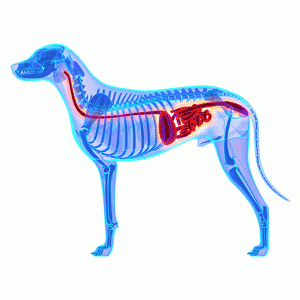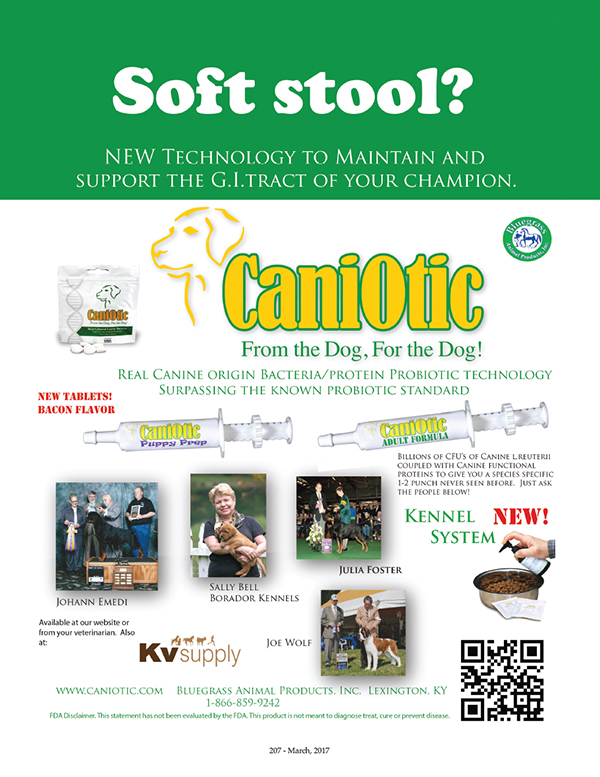Probiotics and Your Dogs – Part 2

By Dr. Bill Bernard, DVM
Probiotics in general and, more specifically, Lactobacillus reuteri. This month we will again stress the importance of these organisms that live inside the gastrointestinal tract of the horse and their impact on health, well-being and performance. Our goal is to provide you with useful information to use as a guide when choosing a probiotic for your Dog and/or kennel.
One of the important functions of “good” bacteria is protection against gastrointestinal disease. The symbiotic bacteria of the GI tract use mechanisms of competitive exclusion by not allowing the bad bacteria to take up residence. They produce metabolites to bind toxins or directly kill pathogens, immobilizing them from causing disease.
Lactobacillus reuteri lives attached to the surface of the GI tract and secretes a product called reuterin that has been shown to kill Salmonella and other pathogens. L. reuteri has been used in humans to treat rota virus and antibiotic induced diarrhea. In other species, L. reuteri has been used against pathogens such E. coli, clostridium, salmonella, coccidiosis, cryptosporidium and others.
Lactobacillus reuteri is a central part of the Microbiome that you hear so much about. This symbiosis is when multiple organisms live together. Mutualism is when two organisms that live together mutually benefit each other. In this respect, L. reuteri participates in the development and management of our immune system by teaching, training and helping it to recognize the good from the bad. Bacteria benefit from this controlled/protected living space of the GI tract.
This benefit to your horse’s health cannot be underestimated.
The adaptive portion of the immune system contains dendritic cells. These cells live under the submucosal layer of the GI tract. However, they are capable of producing a long “arm” which can squeeze through to the surface of the GI tract. This appendage samples various antigens (foreign microscopic particles) to determine whether the substance is friend or foe. The response to a foe is to to present to the innate cells of the immune system by producing an antibody or killer cell in response to the invader.
L. reuteri works with the dendritic cell by sorting, presenting and modulating the response of the dendritic cell. More specifically, L. reuteri has been shown to benefit food-related allergies and to modulate allergic airway response to foreign antigens. All of these immune modulating/protective effects stem from a communication with the immune system made possible through the dendritic cell.
When considering the positive influences of “good” bacteria, it is logical to see that the canine competitor with a healthy GI tract will outperform their counterpart. Dogs with a healthy GI tract travel better, handle stress better, recover from athletic performance better and maintain weight better. The dog with the positive GI tract will have a better chance of reaching its potential than their counterpart.
There are three important considerations when choosing a probiotic for your dog:
1. Viability: Are the bacteria alive? Dead bacteria have little benefit to the dog. Only live organisms can populate the surface of the GI tract and respond in the mutualistic nature intended. Ask yourself if the product is packaged to be alive at time of use. If you open a container with multiple doses that are to be used over several days, the exposure to air/moisture will bring the freeze dried bacteria to life. Without a food source and a living environment, they will rapidly die.
A study at the University of Guelph of the probiotics available for horses found only two of 13 of the products actually contained label claims for numbers of organisms in the product. Viability can be significantly improved by protecting the bacteria in individual serving, vapor proof packets and products in an oil based paste can also have extended half-lives.
2. Numbers of organisms: It is very important that number of organisms given per dose are in the billions, not millions. The bacteria must pass through the acid environment of the stomach in order to reach the site of colonization. During this voyage, some bacteria will invariably be lost.
L reuteri replicates an acidic environment and has actually been found to colonize the stomach. The collective number of probiotic bacteria are represented as CFU (colony forming units). It can be estimated that a sick dog needs as many as 6 billion CFU per day, while a daily maintenance probiotic for the healthy dog should in the range of 2 billion CFU per day depending on size of the dog.

3. Species specific: The bacteria in your probiotic should be species specific to be most effective. In other words, the bacteria you use should have originated from the dog. L. reuteri has specific receptor sites that provide a specific attachment to the surface of its host’s GI tract. This explains why lactobacillus derived from the cow or human is highly unlikely to live and colonize the GI tract of the dog. Additionally, a lactobacillus used to make cheese or yogurt provides minimal to no benefit as a probiotic.
When choosing a probiotic, look for species specificity, high CFU numbers and viability. Packaging, shelf life and labeling are also important considerations when selecting the ideal product for your horse.
Since the early discovery that microorganisms cause disease in plants and animals, science, medicine and agro chemistry have waged war on bacteria, fungi and viruses. However, the current view of microorganisms and their function is eye opening, revealing an amazing potential for new practices in medicine.
The vast majority of bacteria in and on the body are beneficial. There are 10 times as many bacteria in your dog’s body as there are cells. Our modern approach should not be aimed at killing these bacteria, but to understand and support their beneficial contribution to the dog’s health and well-being.
Bill Bernard DVM, ACVIM is board certified in internal medicine and a graduate of University of California, Davis with residency at the University of Pennsylvania, New Bolton Center. He is the author of Equine Pediatric Medicine and numerous scientific papers.


Short URL: http://caninechronicle.com/?p=130898
Comments are closed











